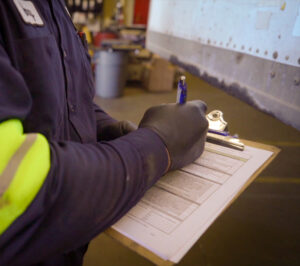Whether you’re considering adding last mile delivery services or are already providing them to your customers, you’ll want to make sure your initiatives are set up for success. Reliable fleet performance is essential as you manage this crucial part of the operation, and to win the “amazing delivery race”, you’ll need to get started much earlier in the process than you might expect.
What’s the Key to Keeping Your Last Mile Fleet Downtime Low? Regular Preventive Maintenance (PM).
Unpredictable maintenance can cause last mile delivery challenges, but they don’t have to result in crisis. The implementation of an infallible PM program can alleviate the need for emergency repairs, solidify high-quality service, and even help deter the burden of normal wear and tear.
PM programs are meant to be just that — preventive. Proactive and prepared to handle repairs before they escalate to an emergency, preventive maintenance ensures that your vehicle stays on the road, improving performance and minimizing impact to your bottom line.
Consider the following seven strategies to maximize your last mile fleet maintenance program’s performance:
1. Find the Delicate Balance Between Your Goals
Last mile delivery challenges can be mitigated by a fleet maintenance program that maximizes uptime at the lowest possible cost. However, herein lies the delicate balance that many fleet executives overlook. “Theoretically, we can touch a vehicle every day to ensure that it’s working properly (check the lights, oil, etc.), but then uptime is significantly decreased, not to mention that this can get very costly,” Peter Souza, Senior Vice President, Safety, Quality and Field Training, Amerit Fleet Solutions says, adding that he urges fleet executives to prioritize the balance of inspection versus cost to meet every goal successfully.
2. Simplify Your Inspection Schedule
Creating a structure that works with your schedule instead of against it helps pave the way to meeting both your inspection and financial goals. Returning to the idea of increased uptime and cost savings, it is wise for fleet executives to schedule repairs that coincide with component manufacturers and regulatory offices.
According to Souza, “The Department Of Transportation requires that their trucks be inspected once per year. Alternatively, California requires inspection every 90 days. There is value in syncing federal and state inspections with your own PM’s to satisfy all checkups at once, rather than having a vehicle sitting idle in a garage more often than necessary.”
3. Identify a Plan
Now that a streamlined inspection calendar has been outlined, it is crucial to be proactive and plan the remainder of your internal timeline. Know what to look for, and when. Predict seasonal weather conditions and how it changes driving conditions and vehicle usage.
Then, schedule appropriate inspections when necessary. “Each vehicle in your fleet is not created equally. The best inspections for a Freightliner truck might not be best for a Volvo,” Souza says. Understanding how each vehicle behaves in different environments and climates adds insight to inspection timelines, which ultimately helps create an advantageous overall plan.
4. Adapt to Emerging Technology Trends
Emerging technologies and trends may call for a complete reassessment of a fleet’s PM program. Although this endeavor presents an additional burden to fleet executives, a large-scale adjustment to your schedule can ultimately save many hours of downtime by addressing the changes in a comprehensive program instead of on a one-by-one basis. “It is critical to observe how technology is changing, and adjust your PM appropriately to stay ahead of the curve,” Souza says.
5. Measure Your Performance
It’s simple — results cannot be improved if your fleet data is not initially measured. If your fleet is experiencing logistical problems or you simply wish to improve performance, measuring your results with accurate data is an essential function to implement.
“If you want to make a change to your vehicle’s cost per mile or your cost per vehicle, you must first have measured specs to use as a guide. Know how often your trucks break down, what parts they most frequently need, and which routes are most or least effective,” Souza says. Without a basis of where your fleet’s standards lie, improvements are impossible to calculate.
6. Focus on Your Challenges
When a fleet’s measured results reveal an issue with performance, Souza advocates for fleet executives to acknowledge and highlight these problem areas and that this is a key to improving the entire fleet.
Asking “What could have been done to make it better?” or “What can be changed to prevent this from happening on a reoccurring basis?” helps maintenance teams and managers create a better process for the future, and avoid last mile delivery challenges. “In some cases, issues are completely unforeseeable,” Souza says. “The key is to address those challenges, rather than avoiding them, in order to solve the underlying problem, put an action plan in place and mitigate the risk of it happening again.”
7. Inspect What You Expect
As an organization grows and a fleet becomes larger, it is important to remember the goals and value propositions that were originally set for your vehicles. Remember that quality is equally as important as quantity, and it is imperative to verify that your last mile fleet maintenance technicians continue to provide value.
“If you are placing so much trust in your technician’s abilities that you neglect to inspect their work, it becomes easy for quality to slip through the cracks,” Souza says. Maintain a solid and frequent assessment of the work you expect from your technicians, and your fleet’s performance is likely to remain at an all-time high.
When your customers expect on-demand services, it’s important to remember that your fleet will need on-demand maintenance. How does fleet maintenance fit into your last mile strategy?




